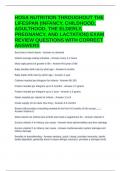-
1. Exam (elaborations) - Hosa – nutrition exam questions with correct answers
-
2. Exam (elaborations) - Hosa nutrition exam guide questions and answers
-
3. Exam (elaborations) - Hosa nutrition exam questions and answers
-
4. Exam (elaborations) - Hosa nutrition exam review questions with correct answers
-
5. Exam (elaborations) - Hosa nutrition practice exam questions with correct answers
-
6. Exam (elaborations) - Hosa nutrition review test questions with complete answers
-
7. Exam (elaborations) - Hosa: nutrition study guide quiz questions with correct answers
-
8. Exam (elaborations) - Hosa nutrition test guide questions and answers
-
9. Exam (elaborations) - Hosa nutrition test questions and answers
-
10. Exam (elaborations) - Nutrition hosa 2024/2025 test questions with complete solutions
-
11. Exam (elaborations) - Hosa nutrition (food allergies and illnesses) exam guide questions and answers
-
12. Exam (elaborations) - Hosa nutrition and diet therapy ch.1 exam questions with correct answers
-
13. Exam (elaborations) - Hosa nutrition- carbohydrates 2024/2025 exam questions and answers
-
14. Exam (elaborations) - Hosa nutrition exam q&a
-
15. Exam (elaborations) - Hosa nutrition knowledge test vocabulary questions with complete answers
-
16. Exam (elaborations) - Hosa nutrition- medical nutrition therapy (diabetes) exam questions with correct answ...
-
17. Exam (elaborations) - Hosa nutrition- minerals exam review questions with correct answers
-
18. Exam (elaborations) - Hosa nutrition nix: carbohydrates exam questions with correct answers
-
19. Exam (elaborations) - Hosa nutrition practice exam guide questions with correct answers
-
20. Exam (elaborations) - Hosa nutrition quiz questions with complete answers
-
21. Exam (elaborations) - Hosa- nutrition study set questions and answers
-
22. Exam (elaborations) - Hosa nutrition test 2024/2025 questions with complete answers
-
23. Exam (elaborations) - Hosa nutrition therapy exam questions and answers
-
24. Exam (elaborations) - Hosa nutrition: vitamins and minerals(t) practice test questions with correct answers
-
25. Exam (elaborations) - Hosa nutrition- water (fluid + electrolyte balance) exam review questions and answers
-
26. Exam (elaborations) - Nutrition hosa exam questions with correct answers
-
27. Exam (elaborations) - Carbohydrates, fats, and proteins questions - hosa nutrition exam questions with corr...
-
28. Exam (elaborations) - Combined hosa nutrition study guide test questions and answers
-
29. Exam (elaborations) - Healthy lifestyle hosa examination review questions and answers
-
30. Exam (elaborations) - Hosa - carbohydrates, fats and proteins test questions with complete answers
-
31. Exam (elaborations) - Hosa - foundations of nutrition exam review questions with correct answers
-
32. Exam (elaborations) - Hosa - nutrition part 2 terms exam questions with complete answers
-
33. Exam (elaborations) - Hosa bowl/ nutrition and diet exam questions and answers
-
34. Exam (elaborations) - Hosa bowl/ nutrition and diet exam questions with complete answers
-
35. Exam (elaborations) - Hosa bowl: nutrition exam set questions with complete answers
-
36. Exam (elaborations) - Hosa nursing assistant: nutrition & fluids exam questions with correct answers
-
37. Exam (elaborations) - Hosa nutrition - chapter 14 exam questions and answers
-
38. Exam (elaborations) - Hosa nutrition - chapter 21 exam questions and answers
-
39. Exam (elaborations) - Hosa nutrition and diet ch.2 exam review questions and answers
-
40. Exam (elaborations) - Hosa nutrition chapter 1 (food, nutrition, and health) exam questions and answers
-
41. Exam (elaborations) - Hosa nutrition chapter 1 basic nutrition diet therapy williams' exam questions with c...
-
42. Exam (elaborations) - Hosa nutrition chapter 3 - digestion, absorption and metabolism exam questions and an...
-
43. Exam (elaborations) - Hosa nutrition community food supply and health, cultures and habits, and weight mana...
-
44. Exam (elaborations) - Hosa nutrition digestion, absorption, and metabolism exam questions with correct answ...
-
45. Exam (elaborations) - And adolescence exam review questions with correct answers
-
46. Exam (elaborations) - Hosa nutrition exam guide questions answers
-
47. Exam (elaborations) - Hosa nutrition- food related illnesses and allergies exam questions with correct answ...
-
48. Exam (elaborations) - Hosa nutrition for cardiovascular patients, diabetics, kidney diseases, and gastroint...
-
49. Exam (elaborations) - Hosa nutrition lipids exam questions and answers
-
50. Exam (elaborations) - Hosa nutrition- medical nutrition therapy (cancer) exam review questions and answers
-
51. Exam (elaborations) - Hosa nutrition- medical nutrition therapy (cardiovascular disease) exam questions and...
-
52. Exam (elaborations) - Hosa nutrition- medical nutrition therapy (gastrointestinal disease) exam questions w...
-
53. Exam (elaborations) - Hosa nutrition practice test questions and answers
-
54. Exam (elaborations) - Hosa nutrition throughout the life span e questions with correct answers
-
55. Exam (elaborations) - Hosa nutrition throughout the lifespan (infancy, childhood, adulthood, the elderly, p...
-
56. Exam (elaborations) - Hosa nutrition vitamins and minerals guide questions with correct answers
-
57. Exam (elaborations) - Hosa nutrition: vitamins exam guide questions with complete answers
-
58. Exam (elaborations) - Hosa nutrition water and electrolyte balance exam questions and answers
-
59. Exam (elaborations) - Hosa nutrition weight management across the life cycle exam questions with correct an...
-
60. Exam (elaborations) - Hosa nutrition weight management across the life cycle exam questions with correct an...
-
61. Exam (elaborations) - Hosa study guide exam questions and answers
-
62. Exam (elaborations) - Medical nutrition therapy (renal disease) – hosa exam questions and answers
-
63. Exam (elaborations) - Medical nutrition therapy, ch.14-21 (hosa nutrition) exam guide questions and answers
-
64. Exam (elaborations) - Nutrition and diets (hosa) exam questions and answers
-
65. Exam (elaborations) - Nutrition hosa exam questions with correct answers
-
Show more




